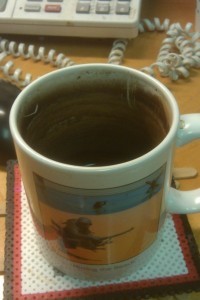The inside of the cup was
covered with a hard, brown substance, so I had to use a scrub brush in order to
make it clean.
Wrong move.
When Kelly and Chris got home, he was less than
pleased that I had cleaned his coffee cup – and a lot of his displeasure stems
from the fact that he spend some time in the Navy.

Like Army coffee, Navy coffee is not particularly good. In the words of a Navy
blogger, “it was hot and strong. Very strong. The thickness of it closely
resembled crude oil. It tasted both wonderful and terrible at the same time.
Your mind can trick you into believing anything. When a supreme pot of joe is
brewed, many of the volunteers would call it “Signal Bridge Coffee,” recalling
the nostalgia of long nights and many cups consumed.
The 1945 Cookbook of the United States Navy lists several reasons why a clean mug and pot
of coffee is essential to a flavorful experience. All parts of the coffee mess
had to be “scrupulously clean,” according to the cook book.
Sailors today might read those guidelines and laugh at the rules and regulations.
Several recent
articles about the practice surfaced on the internet on message boards and
military news blogs. One blogger from the Military Times (Broadside Blog) wrote
about it this past August.
“There are only a few things you need to know about Navy coffee, and most of it involves the cup,” the blogger writes. “You do not
wash a Navy coffee cup. Ever.”
I took Chief Martin’s advice, but not at first. For the first few weeks following our confrontation, I washed my cup out after
he left for the day. But I got lazy after a while. I starting noticing dark
brown rings inside my cup. My mug started to look like the inside of a tree, and
I started to like it. The mug was white, so it was easy to measure my progress.
The rings grew larger and darker until the entire inside was jet back. Although
I was never in the military, I felt a swelling of pride at my Frankenstein
creation. Unfortunately, that mug did not survive. My latest and greatest
creation came about in 2009. It has not been washed or cleaned since its
purchase. I don’t know if my peers understand it. My wife surely doesn’t. I have
a similar mug at home that she avoids looking at, and, on rare occasions, will
clean when I am not looking.
Here is my (meager) contribution to this fine naval tradition. I warn you, if you are unfamiliar with the practice, you might be
shocked. Behold: My four year “seasoned” mug:”

According to The Wall Street Journal, you don’t need to wash your coffee cup every day, unless you happen to
share your coffee cup with someone else, or if you add cream and sugar to your
coffee cup (cream and sugar can lead to mold).
Before you run away screaming from the germ-tastic idea, let’s break this down to figure out if it’s actually
OK to do. Infectious disease expert Jeffrey Starke, a pediatrics professor at
Baylor College of Medicine, tells The Wall Street Journal that even though there
might technically be germs in an unwashed coffee cup, it’s fine because they are
yours. These germs, even if you’re sick, won’t hurt you again if you drink out
of the same mug. “Very few viruses can exist for more than an hour on an inert
object”
Starke said. In fact, Starke says that washing your coffee mug every day
might actually be worse for you, especially if you’re using an old sponge at
your office. The sponge in the break room probably has the highest bacteria
count of anything in the office,” Starke explains. If you are washing your
coffee mug with said sponge, it might benefit from a quick ride in the microwave
to kill off germs.
It’s up to you if you want to wash your coffee cup (or not) but you NEVER want
to drink your coffee out of a Styrofoam cup.
Styrofoam is a brand name for a
material called polystyrene. Polystyrene is injected with gas to get polystyrene
foam which is then used for food packaging. So now you know what you are
drinking if you drink your coffee out of a Styrofoam cup. Polystyrene from
Styrofoam cups and containers can easily get into the food or beverages carried
in them. Styrene is a carcinogen that can cause irritation and secretion of
mucous from the eyes and nose, increase the level of fatigue, decrease the
ability to concentrate, and disrupt the hormone functions resulting in thyroid
problems.
Styrene can take about 500 years to decompose so remember that most of
the food products we purchase today could be disposable but not decomposable.
If you are looking for alternatives to Styrofoam cups, you can use these
environmentally friendly options.
Biodegradable cups: Unlike most cups, these cups do not use a paper jacket but cardboard on the interior of the mug to keep
the heat inside. Also, these cups have lower toxicity levels than traditional
go-to cups.
Reusable coffee mugs: Just go ahead and purchase a reusable coffee
mug such as stainless steel or aluminum. Wash your coffee cup each day, and you
will have a clean, attractive and environmentally friendly alternative.
Oh … If you are wondering where coffee came from in the first place - you can
thank the Muslims.
No comments:
Post a Comment